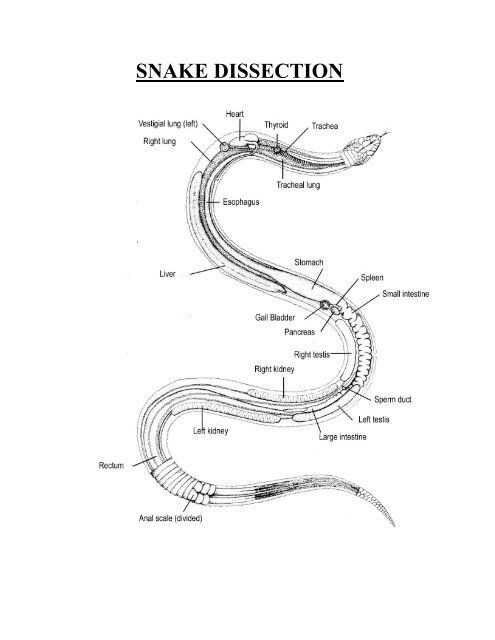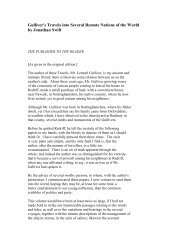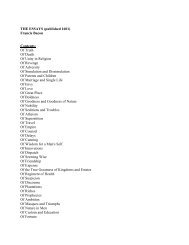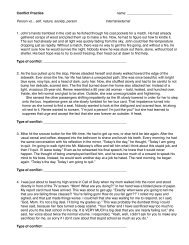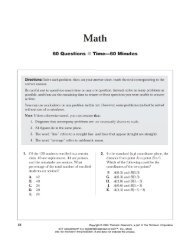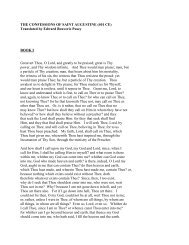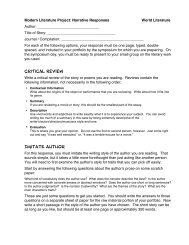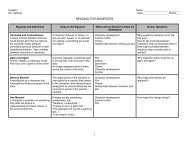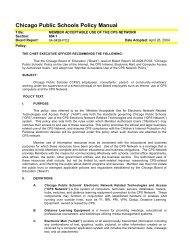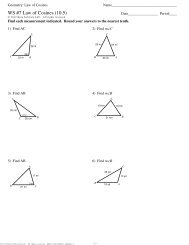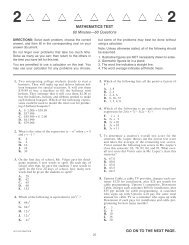SNAKE DISSECTION
SNAKE DISSECTION
SNAKE DISSECTION
Create successful ePaper yourself
Turn your PDF publications into a flip-book with our unique Google optimized e-Paper software.
<strong>SNAKE</strong> <strong>DISSECTION</strong>
INTERNAL ANATOMY<br />
The internal anatomy of the snake is very similar to the anatomy of other vertebrates.<br />
However, there are some differences and we will concentrate on those differences. The<br />
unusual shape of snakes (long and narrow) dictates changes in the form of internal<br />
organs.<br />
Digestive System<br />
1. The Mouth of the snake has a lot of modifications that function to help the animal<br />
swallow (and begin to digest) large prey.<br />
Oral glands in the tongue, below the tongue, and in the lips secrete watery fluids that<br />
moisten the prey, basically covering it (in some snakes) with strong digestive juices.<br />
Duvernoy's glands in some Colubrid snakes secrete a modified saliva that is<br />
venomous. Their venom is released by a duct from this gland that empties into the<br />
mouth near the rear fangs. This modified saliva may be mostly mucous, or contain<br />
enzymes to begin the digestive process. If the digestive component is strong enough it<br />
may be considered venom.<br />
The Venom glands are modified salivary glands with secretions designed to<br />
incapacitate the prey and start the digestion process.<br />
The Jacobson's Organ is a receptacle for the tip of the tongue. The tongue sweeps<br />
molecules from the air, and when inserted into this organs transfers the scent. Snakes<br />
have a far better sense of olfaction than most mammals.<br />
The Esophagus of a snake is very muscular and highly distensible for the passage and<br />
movement of large prey from the mouth to the stomach.<br />
The Stomach secretes a very strong digestive juice that dissolves all of the prey<br />
except for the teeth (and in the case of mammals) the hair. All other parts of the prey<br />
including the bones are digested.<br />
The Pancreas and Gall bladder are similar to other animals in location and function.<br />
The Intestines in snakes are short and uncoiled in snakes due to the fact that they are<br />
carnivores and their bodies are long in form.<br />
The Rectum opens up into the cloaca, which in turn, opens into the vent, the opening<br />
to the outside of the body.<br />
Respiratory System<br />
The snake's respiratory system has had to be highly modified to accommodate the<br />
elongated shape of their body.<br />
The Left Lung in most snake is extremely reduced or entirely absent.<br />
The Right Lung is extremely elongated. In aquatic snake it may extend the entire<br />
length of the body to aid in floatation.<br />
The Tracheal Lung is found wrapped around the trachea in some snakes. It provides<br />
extra air in snakes that eat large prey during swallowing.<br />
The Glottis is a muscular tube in the floor of the mouth that can be extended when<br />
prey is being swallowed. The snake's "hiss" is created by air being forced over a special<br />
membrane in the glottis, causing it to vibrate.
Circulatory System<br />
The Heart has three chambers (mammals have four).<br />
Excretory System<br />
Snakes lack a urinary bladder. They secrete urea in the form of uric acid. This<br />
conserves water and allows the snake to live in areas where water is scarce.<br />
The Kidneys and greatly elongated and alternated so they are not side-by-side.<br />
Reproductive System<br />
The Female Reproductive System<br />
The Ovaries are paired structures that are staggered in snakes to conform to the<br />
elongated body of the snake. Snake eggs have to be large in size to contain enough<br />
nutrients to nourish the embryo during its development.<br />
The Oviduct collects the eggs after they break through the wall of the ovary.<br />
Fertilization of the egg occurs inside the oviduct. The shell is also formed in the lower<br />
part of the oviduct, prior to release of the egg, which exits through the cloaca and vent.<br />
The Male Reproductive System<br />
The Testes are also paired structures that are staggered in snakes to conform to the<br />
elongated body of the snake.<br />
The Seminiferous Tubule carry sperm from the testes to the ureter where they are<br />
stored. The ureter opens into the cloaca, where the sperm travel in a groove that funnels<br />
them to the base of the hemipenis.<br />
The Hemipenes is normally inverted. It has two lobes, one of which functions to<br />
introduce sperm into the cloaca of the female. Either the left or the right hemipenis may<br />
be used. Individual snake seem to prefer one side or the other, but either side in these<br />
individuals can be used effectively. The internal shape of the female cloaca corresponds<br />
to the shape of the male hemipenes of that species. This prevents snakes of different<br />
species from copulating.


